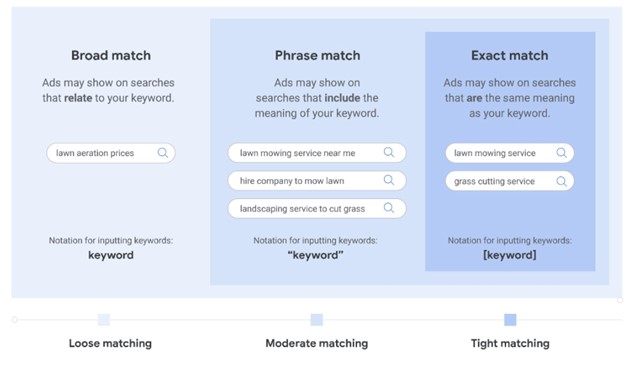Module 5 – Understanding Paid Media Tactics on Google and Youtube
Search ads, display ads, YouTube ads, and more… the options for advertising on Google and YouTube can seem overwhelming. This article will explore the various paid tactics available to help you expand your reach, build engagement and exposure for your business, and generate leads.
Google Search:
Each Google search is a question, and Google search ads allow your business to provide the answer. In other words, you bid on relevant keywords to ensure that your business is seen when these searches happen.
A keyword is a word or phrase describing your product or service that you choose to help Google determine when and where your ad can appear. When you advertise on the Google Search Network, your ad can show near search results when someone performs a search using terms related to one the keywords you’ve selected. With all ads being responsive now, having a clear understanding of keyword types is crucial to reaching the right audiences. The diagram below helps illustrate this, and this link will provide more information on the topic.

Search campaigns can be called Search Engine Marketing (SEM) or Pay Per Click (PPC); these terms are used to describe the same thing.
Best Practices:
- Avoid broad keyword terms so Google can place your ad in front of your target audience.
- Refine your ad copy so that your headline and ad copy match the keywords you’re bidding on.
- Optimize your landing page for conversions. Learn more.
Key Performance Indicators (KPIs):
- Link Clicks
- Click-through rates (CTR)
- Bookings and Transactions
- Return On Ad Spend (ROAS)
Types of Ads:
Branded Search
A branded search query is any search query that contains your unique brand or business name, or some variation of it. A branded search might look like “Ritual Spa” and “Ritual Spa Victoria”, whereas a general paid search would look more like “Spas in Victoria” and “Victoria Spa”.
While your website will appear in organic search results for branded keywords, you can’t easily control which organic listings show up. With paid search ad campaigns, you can experiment with different landing pages, products, deals, ad copy, and more to see which generates the highest click-through rate (CTR) and conversion rate on branded keywords.
Because people searching for your brand name will typically have a higher purchase-intent, branded Search allows you to be competitive with a higher likelihood of converting to a sale.
Category Search
Category search is a method of searching for something without any mention of a specific brand or business name and can be group by category
Example: For Hilton Vancouver Airport: Hotel Near Vancouver Airport, Vancouver Airport Hotel, Best Hotel Near Me
Responsive Text Ads
These are search ads that Google will adapt and customize based on what they feel the user will respond best to, and the search term the users entered. This may improve the performance. Learn more.

Set up your first Google Ad campaign in five simple steps.
Google Display:
Google display ads allow for broad reach and awareness building, but can also be tightly targeted by user behavior, demographics or geo.
They are graphic ads in a variety of shapes and sizes that appear as banner ads and sidebar advertisements on websites. They can alert users to timely events and sales, increase brand awareness or retarget users who have been to the site before with more information. They are typically the top driver of website visits.
Best Practices:
- Develop at least 2 or more creative variations to allow for A/B testing and optimization.
- Ensure your landing page matches your display ad creative messaging.
- The top performing ad sizes include:
- 300×600
- 300×250
- 728×90
- 970×250
- 160×600
- 320×50
- Animated ads (gifs) typically perform best.
- Include a clear call to action. Your CTA should encourage people to click on your ad now. Learn More.
KPIs:
- Link Clicks
- Click Through Rate (CTR)
- Revenue
- Transactions
- Return On Ad Spend (ROAS)
Types of Ads:
- Static: a traditional ad that includes text or images that doesn’t move
- Animated: a GIF
- Interactive: engages a user to take action, for example, play a game or take a poll
- Floating: a type of pop-up ad which doesn’t disappear while scrolling
- Expanding: after a user click this ad, it becomes bigger in size
- Video: a video ad
YouTube:
After Google, YouTube is the most used search engine. It’s important that your YouTube channel and videos are optimized for search with clear titles and descriptions.
YouTube is a highly engaging platform where movies, recipes, and many more videos are viewed every day. Videos must be loaded on to an active YouTube channel as “public” for it to be used for an ad.
Video ads can be created to be skippable or non-skippable, based on the length and goal.
You can be very specific based on where you want your ads to show.
You can target locations, popular content creators, or broad topics that best relate to your offerings.
Best Practices:
- Keep your videos within the 15-60 second range. Studies show that 30-second ads have the highest view-through rate.
- Hook the audience within the first 7 seconds.
- Include a clear call to action (CTA) to encourage people to click on your ad now.
- Test, test, test! Keep refining your keywords, bids, audience targeting, and the content and format of the ad itself.
KPIs:
- Views
- Impressions
- Unique users
- View-Through Rate
- Watch Time
- Link Clicks
- Click Through Rate (CTR)
- Revenue
- Transactions
- Return On Ad Spend (ROAS)
Types of Ads:
- Skippable in-stream ads
- Non-skippable in-stream ads
- In-feed video ads
- Bumper ads (play before, during, or after another video)
- Outstream ads (mobile-only ads)
- Masthead ads (appears in the YouTube Home feed across all devices)
Performance Max campaigns (PMax):
Performance Max is a campaign type that allows advertisers to access all of their Google Ads inventory from a single campaign. PMax is Google’s newest and most comprehensive campaign for advertisers, allowing for the most streamlined service across a variety of platforms.





